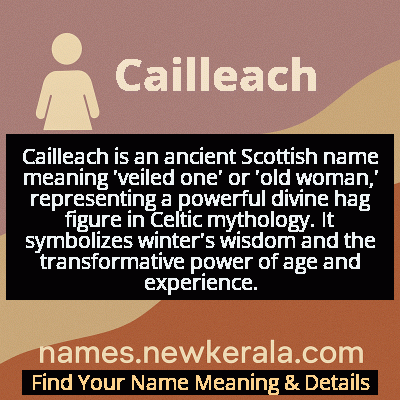Cailleach Name Meaning & Details
Origin, Popularity, Numerology Analysis & Name Meaning of Cailleach
Discover the origin, meaning, and cultural significance of the name CAILLEACH. Delve into its historical roots and explore the lasting impact it has had on communities and traditions.
Name
Cailleach
Gender
Female
Origin
Scottish
Lucky Number
9
Meaning of the Name - Cailleach
Cailleach is an ancient Scottish name meaning 'veiled one' or 'old woman,' representing a powerful divine hag figure in Celtic mythology. It symbolizes winter's wisdom and the transformative power of age and experience.
Cailleach - Complete Numerology Analysis
Your Numerology Number
Based on Pythagorean Numerology System
Ruling Planet
Mars
Positive Nature
Generous, passionate, energetic, and humanitarian.
Negative Traits
Impulsive, impatient, moody, and can be overly emotional.
Lucky Colours
Red, maroon, scarlet.
Lucky Days
Tuesday.
Lucky Stones
Red coral, garnet.
Harmony Numbers
1, 2, 3, 6.
Best Suited Professions
Military, sports, philanthropy, leadership roles.
What People Like About You
Courage, energy, leadership, generosity.
Famous People Named Cailleach
Cailleach Bheur
Mythological Figure
Divine hag who created mountains and controlled winter in Scottish folklore
Cailleach nan Cruachan
Mythological Figure
Specific manifestation associated with the mountains of Argyll, particularly Ben Cruachan
Cailleach Beinne Bric
Mythological Figure
Mountain hag figure from Highland traditions, associated with specific landscapes
Name Variations & International Equivalents
Click on blue names to explore their detailed meanings. Gray names with will be available soon.
Cultural & Historical Significance
Beyond her mythological role, the Cailleach represents important cultural values including respect for elders, understanding of natural cycles, and recognition of the necessary harshness that precedes renewal. She appears in numerous local legends across Scotland, often associated with specific geographical features, demonstrating how mythology was used to explain and relate to the environment. The figure also embodies the concept of sovereignty - the land and its ruler being intrinsically connected - and serves as a reminder of the power and wisdom that comes with age and experience in Celtic society.
Extended Personality Analysis
The personality associated with Cailleach reflects the characteristics of the mythological figure - immense wisdom gained through countless cycles of existence, formidable strength in adversity, and deep connection to natural rhythms. Those embodying this archetype typically display remarkable resilience, having weathered many 'winters' in their lives and emerged with greater understanding. They possess a no-nonsense practicality combined with ancient knowledge, often serving as guardians of tradition and community memory.
This personality type demonstrates protective fierceness toward what they value, whether family, community, or principles, while maintaining the wisdom to know when to step back and allow new growth. There's often a paradoxical combination of harsh exterior masking deep nurturing instincts, much like winter preserves the earth for spring's renewal. The Cailleach personality understands that difficulty serves purpose, that endings make new beginnings possible, and that true strength includes both the power to preserve and the wisdom to transform when the season demands it.
Modern Usage & Popularity
In modern usage, Cailleach remains primarily a mythological and cultural reference rather than a common given name. It sees occasional use in Scotland among families with strong Gaelic heritage connections, though it remains quite rare. The name has found more significant presence in neopagan and Celtic spiritual communities, where it is used as a ritual name or title honoring the ancient goddess figure. In artistic and literary contexts, Cailleach appears frequently as a symbol of ancient wisdom, winter's power, or Scottish cultural identity. The name maintains steady recognition in folk music, poetry, and environmental movements that draw on Celtic traditions of land reverence, though its usage as a personal name for children remains minimal due to its strong mythological associations and meaning as 'hag' or 'old woman'.
Symbolic & Spiritual Meanings
The Cailleach symbolizes the essential paradox of creation through destruction - the understanding that winter's death makes spring's rebirth possible. She represents the wisdom that comes from surviving difficult cycles, the power of age and experience over youthful vigor, and the necessary harshness that strengthens and prepares for new growth. Symbolically, she embodies the land itself in its most ancient, raw form - the bedrock beneath the soil, the mountain that withstands storms, the wisdom accumulated over eons of seasonal turns.
Her symbolism extends to concepts of sovereignty and stewardship, representing the deep connection between people and place, and the responsibility that comes with power. The Cailleach teaches that true strength includes both the capacity to endure and the wisdom to transform, that endings are inherent in beginnings, and that what appears barren often contains the most potent seeds of new life. She symbolizes the respect due to age and experience, and the understanding that the most valuable wisdom often comes from surviving what others cannot endure.

